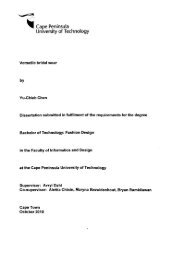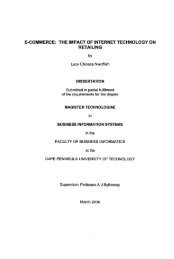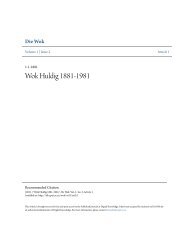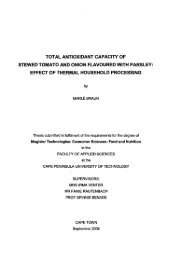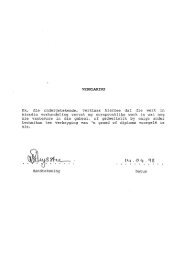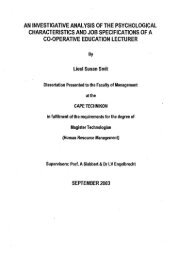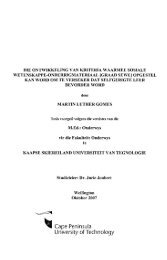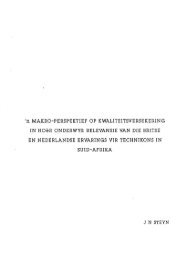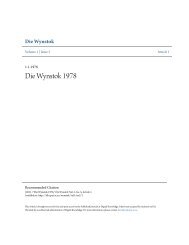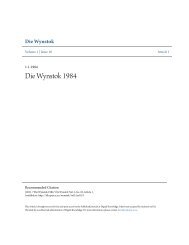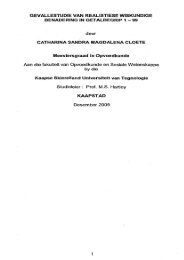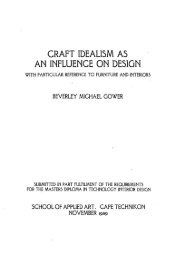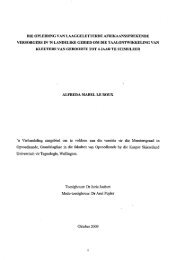the effect of the particle size distribution on non-newtonian turbulent ...
the effect of the particle size distribution on non-newtonian turbulent ...
the effect of the particle size distribution on non-newtonian turbulent ...
Create successful ePaper yourself
Turn your PDF publications into a flip-book with our unique Google optimized e-Paper software.
Appendix B C<strong>on</strong>ference Paper B.18<br />
This investigati<strong>on</strong> highlights <str<strong>on</strong>g>the</str<strong>on</strong>g> fact that <str<strong>on</strong>g>the</str<strong>on</strong>g> PSD is a vitally important property <str<strong>on</strong>g>of</str<strong>on</strong>g> <str<strong>on</strong>g>the</str<strong>on</strong>g><br />
slurry and should be used for <str<strong>on</strong>g>the</str<strong>on</strong>g> <strong>turbulent</strong> flow analysis <str<strong>on</strong>g>of</str<strong>on</strong>g> n<strong>on</strong>-Newt<strong>on</strong>ian slurries, as<br />
has been used in <str<strong>on</strong>g>the</str<strong>on</strong>g> <str<strong>on</strong>g>the</str<strong>on</strong>g>ory for <str<strong>on</strong>g>the</str<strong>on</strong>g> new analysis, to account for rough wall <strong>turbulent</strong><br />
flow and to predict <str<strong>on</strong>g>the</str<strong>on</strong>g> change from smooth wall to rough wall <strong>turbulent</strong> flow.<br />
Park et al (1989) and Pokryvalio & Grozberg (1995) used very different slurries and<br />
experimental techniques, yet both reported significantly higher relative turbulence<br />
intensities in <str<strong>on</strong>g>the</str<strong>on</strong>g> wall regi<strong>on</strong> for <str<strong>on</strong>g>the</str<strong>on</strong>g>ir slurries, when compared with air. This empirical<br />
evidence str<strong>on</strong>gly supports <str<strong>on</strong>g>the</str<strong>on</strong>g> c<strong>on</strong>cept <str<strong>on</strong>g>of</str<strong>on</strong>g> <str<strong>on</strong>g>particle</str<strong>on</strong>g> roughness turbulence.<br />
Where Slarter's model fails to -accurately predict Sive's data it is felt <str<strong>on</strong>g>the</str<strong>on</strong>g> reas<strong>on</strong> is that<br />
<str<strong>on</strong>g>the</str<strong>on</strong>g> slurries tested by Sive were settling slurries and not homogenous slurries <strong>on</strong> which<br />
<str<strong>on</strong>g>the</str<strong>on</strong>g> <str<strong>on</strong>g>the</str<strong>on</strong>g>oretical model was originally based. Fur<str<strong>on</strong>g>the</str<strong>on</strong>g>r investigati<strong>on</strong> is required to determine<br />
<str<strong>on</strong>g>the</str<strong>on</strong>g> limit <str<strong>on</strong>g>of</str<strong>on</strong>g> validity <str<strong>on</strong>g>of</str<strong>on</strong>g> <str<strong>on</strong>g>the</str<strong>on</strong>g> <str<strong>on</strong>g>particle</str<strong>on</strong>g> roughness <str<strong>on</strong>g>effect</str<strong>on</strong>g>. In fact, <str<strong>on</strong>g>the</str<strong>on</strong>g> limit <str<strong>on</strong>g>of</str<strong>on</strong>g> validity <str<strong>on</strong>g>of</str<strong>on</strong>g> <str<strong>on</strong>g>the</str<strong>on</strong>g><br />
<str<strong>on</strong>g>particle</str<strong>on</strong>g> roughness <str<strong>on</strong>g>effect</str<strong>on</strong>g> could provide a more logical basis for vehicle/load cut-<str<strong>on</strong>g>of</str<strong>on</strong>g>f in<br />
mixed regime slurries than is used at present.<br />
Future <str<strong>on</strong>g>the</str<strong>on</strong>g>oretical modelling <str<strong>on</strong>g>of</str<strong>on</strong>g>n<strong>on</strong>-Newt<strong>on</strong>ian slurries should take into account both <str<strong>on</strong>g>the</str<strong>on</strong>g><br />
PSD and <str<strong>on</strong>g>the</str<strong>on</strong>g> rheology <str<strong>on</strong>g>of</str<strong>on</strong>g> <str<strong>on</strong>g>the</str<strong>on</strong>g> slurry.<br />
6. CONCLUSION<br />
Particle roughness turbulence does not apply to settling slurries (as tested by Sive,<br />
1988). Fur<str<strong>on</strong>g>the</str<strong>on</strong>g>r investigati<strong>on</strong> is required to determine <str<strong>on</strong>g>the</str<strong>on</strong>g> limit <str<strong>on</strong>g>of</str<strong>on</strong>g>validity <str<strong>on</strong>g>of</str<strong>on</strong>g> <str<strong>on</strong>g>the</str<strong>on</strong>g> <str<strong>on</strong>g>particle</str<strong>on</strong>g><br />
roughness <str<strong>on</strong>g>effect</str<strong>on</strong>g>, and this limit could well serve as <str<strong>on</strong>g>the</str<strong>on</strong>g> criteri<strong>on</strong> for vehic1elload cut-<str<strong>on</strong>g>of</str<strong>on</strong>g>f<br />
in mixed regime slurries.<br />
The <str<strong>on</strong>g>particle</str<strong>on</strong>g> roughness turbulence model is <str<strong>on</strong>g>the</str<strong>on</strong>g> first model to incorporate <str<strong>on</strong>g>the</str<strong>on</strong>g> c<strong>on</strong>tinuum<br />
compromise which must arise as <str<strong>on</strong>g>the</str<strong>on</strong>g> laminar sub-layer thickness is limited, and it is <str<strong>on</strong>g>the</str<strong>on</strong>g><br />
<strong>on</strong>ly model to explain <str<strong>on</strong>g>the</str<strong>on</strong>g> empirical evidence <str<strong>on</strong>g>of</str<strong>on</strong>g> increased turbulence intensities in <str<strong>on</strong>g>the</str<strong>on</strong>g><br />
wall regi<strong>on</strong>.<br />
It can be c<strong>on</strong>cluded from <str<strong>on</strong>g>the</str<strong>on</strong>g> test data results that <str<strong>on</strong>g>the</str<strong>on</strong>g> new approach to turbulence<br />
modelling using <str<strong>on</strong>g>the</str<strong>on</strong>g> <str<strong>on</strong>g>particle</str<strong>on</strong>g> roughness <str<strong>on</strong>g>effect</str<strong>on</strong>g> is valid and can be successfully adopted for<br />
n<strong>on</strong>-Newt<strong>on</strong>ian slurries.<br />
Acknowledgement<br />
The co-operati<strong>on</strong> <str<strong>on</strong>g>of</str<strong>on</strong>g> Pr<str<strong>on</strong>g>of</str<strong>on</strong>g>. Mike de Kock for <str<strong>on</strong>g>the</str<strong>on</strong>g> use <str<strong>on</strong>g>of</str<strong>on</strong>g> <str<strong>on</strong>g>the</str<strong>on</strong>g> Hydrotransport test facilities<br />
at <str<strong>on</strong>g>the</str<strong>on</strong>g> University <str<strong>on</strong>g>of</str<strong>on</strong>g> Cape Town is gratefully acknowledged.



